Pesticides and Cholinesterase
This publication describes cholinesterase, as well as how several pesticides in different pesticide families can affect cholinesterase levels in humans, and the importance of timely monitoring of cholinesterase levels for any who handle organophosphate or carbamate pesticides, which inhibit cholinesterase.
Cholinesterase
Cholinesterase, or, more properly, acetylcholinesterase, is an enzyme essential for normal functioning of the nervous system of humans, other vertebrates, birds, and insects. In the body, acetylcholinesterase inactivates the chemical messenger acetylcholine, which is normally active at the junctions between nerves and muscles, between many nerves and glands, and at the synapses between certain nerves in the central nervous system. When cholinesterase levels are low because of excessive inhibition, the nervous system can malfunction, which can lead to death.
Certain chemical families of pesticides, such as organophosphates and carbamates (Table 1) work primarily (with a few exceptions) against arthropod pests by interfering with or inhibiting cholinesterase. While the effects of cholinesterase-inhibiting products are intended for pests, these chemicals can also be poisonous — toxic — to humans in some situations. Human exposure to cholinesterase-inhibiting chemicals can result from inhalation, ingestion, or eye or skin contact during the manufacture, mixing, or applications of these pesticides.
Exposure
Cholinesterase inhibition due to exposure to these families of pesticides can cause acute or delayed effects, ranging from mild to severe poisoning (Table 2). Each person has a certain baseline level of cholinesterase enzyme that is considered normal for that individual. Exposure to carbamate and organophosphate pesticides inhibits cholinesterase, resulting in continual overexcitation of nerve-to-nerve and nerve-to-muscle communication.
Extreme exposure to pesticides that inhibit cholinesterase — exposure resulting, for example, from spilling concentrates on oneself — can cause immediate illness. Lesser exposures may not cause symptoms that are immediately apparent. However, small, repeated exposures to such pesticides over several days or weeks can over time reduce the cholinesterase level in the exposed person. Such repeated exposures can ultimately trigger mild, moderate, or severe symptoms of overexposure. (Persons who only occasionally are exposed to these pesticides through residues in and around structures or landscapes or through residues on foods are not considered to be at risk.)
In human reactions to cholinesterase inhibition, it is not always obvious whether a person is showing symptoms from an acute exposure or experiencing delayed effects from repeated exposures. For example, a pesticide handler exposed to a single, large dose of a cholinesterase-inhibiting pesticide may immediately suffer acute effects. However, if over an extended period of time, the pesticide handler is exposed to several small amounts of such pesticides, the handler's cholinesterase levels may be reduced slightly at each exposure. Eventually, a small additional exposure can cause illness. In this example, the illness may arise soon after exposure, but only following previous reductions in cholinesterase due to earlier exposures.
Cholinesterase Monitoring
Some states require employers to enroll their employees who handle such pesticides in a cholinesterase-monitoring program. Although Florida law does not require employers of pesticide handlers to monitor these employee's cholinesterase levels, some employers in Florida — including the University of Florida — voluntarily enroll their employees who handle pesticides in a cholinesterase-monitoring program.
Regardless of what the law requires or allows from state to state, however, any who handle carbamates and organophosphates should consult with their physician for regular cholinesterase testing. The blood cholinesterase test measures the effect of exposure to these pesticides. Cholinesterase levels can vary considerably between individuals, so a baseline must be established for each person prior to handling such pesticides or at least 30 days from the most recent exposure to carbamates and organophosphates.
Establishing an accurate baseline value often requires that two tests be performed at least 72 hours apart, but not more than 14 days apart. Handlers of carbamates and organophosphates should have their cholinesterase levels monitored periodically, so they can compare results with the previously established baseline level.
A significant reduction in the cholinesterase level indicates exposure. When exposure is indicated, a physician will normally suggest that the pesticide handler be removed from further exposure until the body has had time to sufficiently build new cholinesterase. The ill effects of carbamates last for a relatively short period of time. However, it takes much longer for the body to manufacture new cholinesterase following exposure to organophosphates.
Physicians will establish the frequency of testing. Those physicians who specialize in occupational and environmental medicine are most familiar with this type of testing program.
Minimizing Exposure
Reading and following product label directions is a cornerstone for minimizing exposure to carbamates, organophosphates, and all pesticides. Product labels will identify if the pesticide is a cholinesterase inhibitor. The statement will normally be found in the First Aid section of the label (Figure 1).

Credit: UF/IFAS Pesticide Information Office
Exposure can be minimized through special caution when handling these concentrates, as well as by wearing clean, protective clothing, and showering each day after application of the pesticide. If monitoring shows decreased levels of cholinesterase, handlers should analyze their practices to determine how to reduce future exposure to cholinesterase-inhibiting chemicals.
Additional Information
Nesheim, O.N., F.M. Fishel, and M.A. Mossler. 2005. Toxicity of Pesticides. PI-13. Gainesville: University of Florida Institute of Food and Agricultural Sciences. https://edis.ifas.ufl.edu/pi008 (accessed September 2015).
Reigart, J.R., and J.R. Roberts. 2013. Recognition and management of pesticide poisonings, 6th ed. United States Environmental Protection Agency Publication EPA 735K13001.
Seyler, L.A., et.al. 1994. Extension toxicology network (EXTOXNET). Cornell University and Michigan State University. http://extoxnet.orst.edu/index.html (accessed September 2015).


